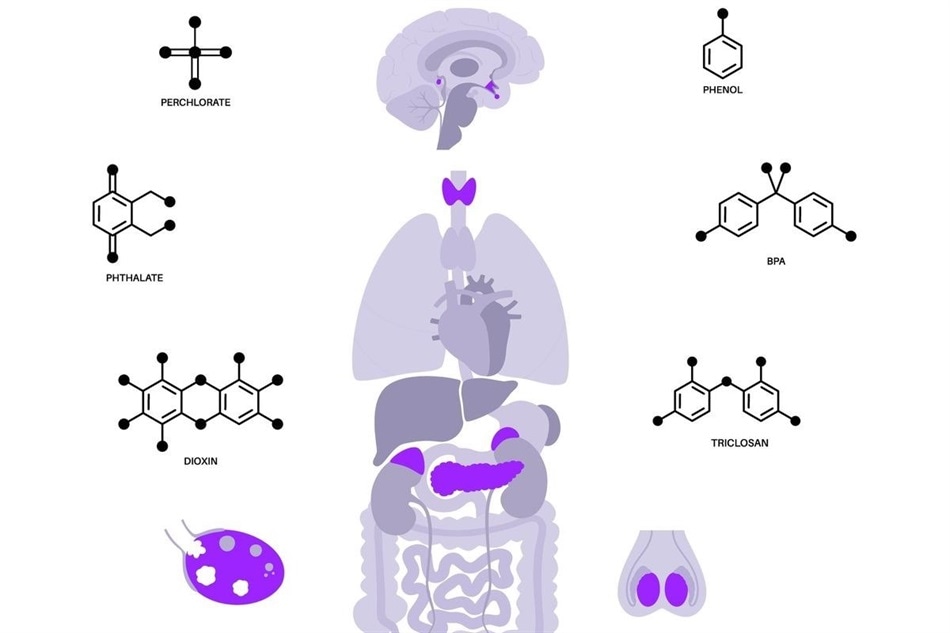In the intricate dance of human biology, hormones serve as the master conductors orchestrating countless vital functions. These chemical messengers, secreted by glands such as the thyroid, adrenal, and reproductive organs, regulate growth, metabolism, mood, reproduction, and immune response. Their balance is delicate and precise, finely tuned by evolutionary forces over millions of years.
Imagine hormones as whispers traveling through the bloodstream, carrying instructions to distant cells. Any interference in this communication system can cause a ripple effect of disruptions, potentially derailing entire physiological systems. This is where endocrine disruptors enter the stage—substances that stealthily mimic, block, or alter hormone signals and throw the body’s balance into chaos.
What Are Endocrine Disruptors and Where Do They Come From
Endocrine disruptors are chemicals, often man-made, that interfere with the normal function of the endocrine system. Unlike acute toxins that cause immediate harm, endocrine disruptors can exert subtle, long-term effects even at very low levels of exposure. These compounds are found in a vast array of everyday products—from plastics and pesticides to personal care items and industrial chemicals.
Common endocrine disruptors include bisphenol A (BPA), phthalates, polychlorinated biphenyls (PCBs), dioxins, and certain pesticides such as DDT. BPA is notorious for its presence in plastic containers and canned food linings, while phthalates lurk in fragrances, cosmetics, and flexible plastics. Their pervasive presence means exposure is nearly universal, raising urgent questions about the cumulative health impact on humans.
How Endocrine Disruptors Hijack the Hormonal Messaging System
To understand the damage caused by endocrine disruptors, we must first appreciate the sophisticated precision of hormone signaling. Hormones bind to specific receptors on or inside cells, triggering carefully regulated responses. Endocrine disruptors can mimic these hormones by binding to the receptors themselves, producing false signals. Alternatively, they can block hormone receptors, preventing natural hormones from delivering their message.
Some disruptors interfere with hormone synthesis, metabolism, or transport, altering the levels of hormones circulating in the body. Others may affect the timing and pattern of hormone release, which is crucial during sensitive developmental periods such as fetal growth, puberty, or pregnancy. The result is a biological cacophony, where signals are sent, blocked, or distorted, leading to physiological confusion and dysfunction.
Early Life Exposure Shapes a Lifetime of Health Outcomes
Perhaps most alarming is how endocrine disruptors affect the developing human. The fetal period and early childhood represent windows of incredible vulnerability. During these stages, hormones guide the formation of organs, neural circuits, and reproductive systems. Exposure to disruptors during this time can permanently alter development, sometimes with consequences that only manifest decades later.
Scientific studies have linked prenatal exposure to endocrine disruptors with altered brain development, increased risk of neurodevelopmental disorders such as autism and ADHD, and abnormalities in reproductive tract formation. For example, male infants exposed in utero to phthalates show changes in genital development and hormone levels, suggesting potential future fertility problems.
This concept of “programming” highlights how transient exposures early in life can set the stage for chronic diseases like diabetes, obesity, and cardiovascular disorders that emerge in adulthood. It rewrites the simplistic notion of toxicity, revealing how low-level, persistent chemical insults can reshape human biology from its very foundation.
Reproductive Health and Fertility Under Siege
The endocrine system plays an indispensable role in reproductive health, regulating menstrual cycles, sperm production, sexual differentiation, and pregnancy maintenance. Endocrine disruptors undermine this system with profound consequences.
In women, exposure to certain disruptors correlates with irregular menstrual cycles, earlier onset of puberty, and increased incidence of endometriosis and polycystic ovary syndrome (PCOS). In men, studies show associations with decreased sperm count, poor sperm motility, and altered testosterone levels. These reproductive effects are concerning not only for individual health but also for global fertility trends, which show worrying declines in sperm quality and birth rates in many countries.
Additionally, endocrine disruptors can interfere with placental function, potentially leading to pregnancy complications such as preeclampsia, miscarriage, or low birth weight. The implications extend beyond individual families, touching on public health and demographic stability.
The Growing Epidemic of Metabolic Disorders Linked to Disruptors
Obesity, diabetes, and metabolic syndrome have reached epidemic proportions worldwide, and endocrine disruptors may be silent contributors. Some disruptors, termed “obesogens,” interfere with fat cell development, appetite regulation, and energy metabolism.
Research indicates that chemicals like BPA and certain pesticides can promote weight gain by altering how the body stores fat and responds to insulin. They may also disrupt thyroid function, which plays a key role in metabolic rate regulation. The result is an increased risk of insulin resistance, type 2 diabetes, and cardiovascular diseases.
Unlike diet and exercise, exposure to these chemical disruptors is often invisible and uncontrollable by individuals. This complicates prevention efforts and underscores the importance of regulatory action to reduce population-wide exposure.
Neurodevelopment and Cognitive Effects Reveal a Disturbing Pattern
The brain is exquisitely sensitive to hormonal cues, especially during its development. Endocrine disruptors that cross the placental barrier or enter breast milk can alter neuroendocrine pathways, neurotransmitter systems, and neuronal connectivity.
Epidemiological studies link prenatal and early-life exposure to certain disruptors with deficits in IQ, learning disabilities, behavioral problems, and increased risk of neuropsychiatric conditions. For instance, polychlorinated biphenyls (PCBs) exposure is associated with poorer cognitive function and attention deficits in children. Phthalates and BPA exposure have also been implicated in altered behavior and emotional regulation.
The potential for widespread neurodevelopmental impact is alarming given how many children worldwide are exposed to these chemicals. This raises critical questions about environmental justice, as vulnerable populations often experience higher exposures due to socioeconomic and geographic factors.
Cancer Risk and Endocrine Disruption Intertwine in Complex Ways
Many cancers, particularly those of hormone-sensitive tissues such as breast, prostate, and thyroid, have been linked to endocrine disruptors. These chemicals can promote carcinogenesis by mimicking estrogens or androgens, leading to abnormal cell proliferation.
For example, BPA has been shown to stimulate breast cancer cell growth in laboratory studies. Epidemiological data suggest associations between exposure to certain pesticides and increased risk of non-Hodgkin lymphoma or testicular cancer. Additionally, the timing of exposure is critical, with early life and puberty representing particularly vulnerable windows.
While establishing direct cause-effect relationships is challenging due to the complexity of cancer etiology and exposure mixtures, the evidence warrants precautionary measures. The insidious nature of endocrine disruptors, often acting over decades, complicates traditional toxicological assessments.
Immune System and Endocrine Disruptors Engage in a Subtle Battle
Beyond reproductive, metabolic, and neurological effects, emerging research highlights how endocrine disruptors may modulate immune function. Hormones regulate immune responses, maintaining the balance between defense against pathogens and prevention of autoimmune disease.
Disruptors that interfere with hormone signaling can alter immune cell development, inflammatory pathways, and susceptibility to infections. For instance, some studies suggest that prenatal exposure to endocrine disruptors is linked to increased allergies, asthma, and autoimmune conditions in children.
This interplay between the endocrine and immune systems adds another layer of complexity to understanding how chemicals in our environment influence health, hinting at multifaceted effects that transcend traditional organ-based classifications.
The Challenge of Identifying and Measuring Exposure in Humans
One of the greatest hurdles in studying endocrine disruptors is the complexity of human exposure. Unlike traditional toxins, these chemicals are ubiquitous, found in food, air, water, consumer products, and even dust. Exposure is often chronic, at low doses, and involves mixtures of multiple chemicals.
Measuring internal dose requires sophisticated biomonitoring techniques, such as analyzing blood, urine, or breast milk for chemical metabolites. These measurements reveal that almost everyone carries some level of endocrine disruptors, but interpreting what this means for health is difficult.
The timing of exposure, genetic susceptibility, nutrition, and other environmental factors all modulate risk, creating a puzzle with many interacting pieces. Despite advances in epidemiology and toxicology, much remains unknown about the full scope of human health effects.
Policy, Prevention, and the Role of Public Awareness
Given the growing evidence of harm, regulating endocrine disruptors is both a scientific and political challenge. Many chemicals have been banned or restricted, such as DDT and PCBs, but newer compounds like BPA substitutes and flame retardants continue to emerge.
Precautionary approaches, including reducing unnecessary chemical use, improving product labeling, and promoting safer alternatives, are gaining traction. Consumer awareness has sparked demand for “BPA-free” or “phthalate-free” products, although such labels can sometimes be misleading or incomplete.
Public health campaigns emphasize minimizing exposure through simple steps like avoiding microwaving plastics, choosing fresh foods over canned, and using fragrance-free personal care items. At the same time, advocacy for stronger governmental regulations and corporate responsibility continues.
The Path Forward Lies in Science, Innovation, and Collective Action
Understanding how endocrine disruptors affect human health demands interdisciplinary research—combining biology, chemistry, epidemiology, and social sciences. New technologies like high-throughput screening, computational modeling, and “omics” approaches offer unprecedented insights into mechanisms of action and population risk.
Global cooperation is vital. Chemicals cross borders invisibly, and policies in one country can be undermined by lax regulations elsewhere. International treaties like the Stockholm Convention aim to reduce persistent organic pollutants, yet many challenges remain.
Most importantly, addressing endocrine disruption requires rethinking how we design and manufacture products, shifting toward sustainability and health-conscious innovation. By embracing a precautionary, science-based approach, society can reduce chemical burdens and protect future generations from invisible threats.
Conclusion Endocrine Disruptors Represent a Modern Health Challenge
Endocrine disruptors have emerged as silent saboteurs of human health, undermining the complex hormonal systems that sustain life. Their subtle yet pervasive influence spans development, reproduction, metabolism, cognition, immunity, and cancer risk.
While the science continues to evolve, the evidence compels us to rethink our relationship with the chemical environment. Protecting ourselves and future generations demands vigilance, innovation, and policy action informed by rigorous research.
In a world awash with synthetic chemicals, understanding endocrine disruptors is more than an academic pursuit—it is a public health imperative. As we unravel these invisible threats, we move closer to a future where human biology and the environment can coexist in healthier harmony.






